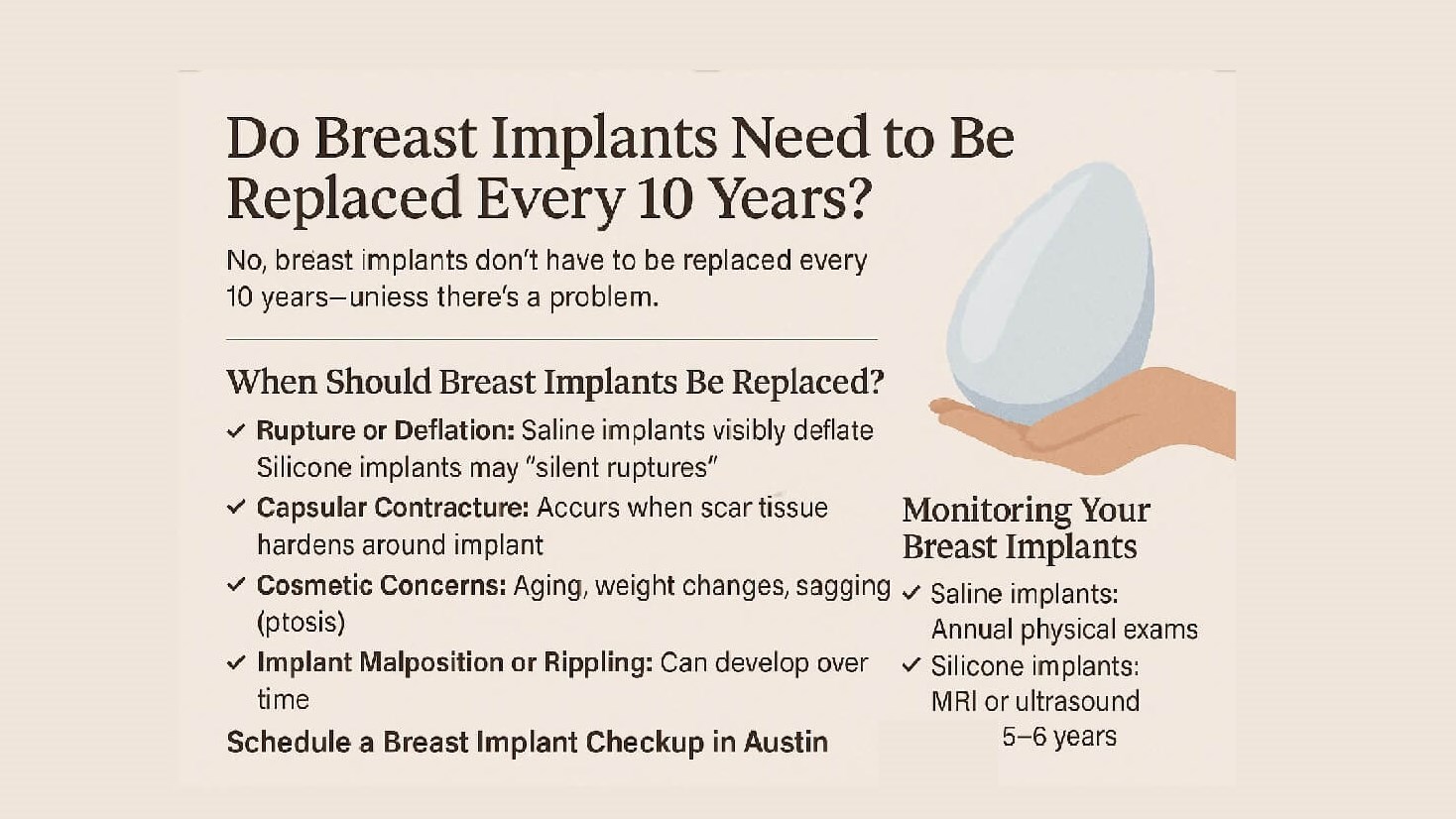Do Breast Implants Need to Be Replaced Every 10 Years?
&srotate=0)
If you’re considering breast augmentation—or already have breast implants—you’ve likely heard that they need to be replaced every 10 years. But is this true, or just a persistent myth?
At Levesque Plastic Surgery in Austin, we often hear this question from patients during consultations. The short answer: no, breast implants don’t have to be replaced every 10 years—unless there’s a problem. In this blog, we’ll explain where the “10-year rule” comes from, what can affect implant lifespan, and when replacement might actually be needed.
Where Did the “10-Year Rule” Come From?
The idea that implants must be replaced every decade comes from early FDA studies and manufacturer warranties. Many implant manufacturers originally offered 10-year warranties, which led to the assumption that implants “expire” at the end of that period.
However, advances in implant materials, surgical techniques, and monitoring technology have improved longevity. Today, both silicone and saline implants can last well beyond 10 years without causing any issues.
How Long Do Breast Implants Really Last?
Most modern breast implants are designed to last 15–20 years or longer. In fact, some women may never need their implants replaced.
However, like any medical device, implants are not lifetime devices. Their longevity depends on:
- Type of implant (silicone vs. saline)
- Surgical technique (whether an insertion sleeve is used)
- Lifestyle factors
- Individual body response
- History of complications (e.g., rupture, capsular contracture)
- Luck or bad luck
When Should Breast Implants Be Replaced?
You don’t need to replace your breast implants at a specific time unless you're experiencing symptoms or complications. Here are the most common reasons patients return for breast implant revision:
- Rupture or Deflation
- Saline implants deflate visibly when ruptured.
- Silicone implants may show no symptoms this is known as a “silent rupture.” That’s why the FDA recommends routine imaging (MRI or ultrasound) starting at 5–6 years.
- Capsular Contracture - This occurs when the scar tissue around the implant hardens, causing discomfort or changes in appearance.
- Cosmetic Concerns
- Natural aging
- Weight changes
- Breast sagging (ptosis)
- Desire to change implant size or switch to fat grafting
- Implant Malposition or Rippling - This can occur over time, especially with thinner patients or older implants.
Monitoring Your Breast Implants
We always recommend patients schedule routine follow-ups and imaging based on implant type and age. Here's a general guide:
- Saline implants: Physical exams annually; replacement if deflation occurs.
If a saline implant ruptures the body absorbs that fluid and it is easily seen that there has been a rupture.
- Silicone implants: MRI or ultrasound at 5–6 years, then every 2–3 years.
Silicone implants may rupture but given they are semisolid the shape of the breast may not change at all so an
MRI or ultrasound can be used to confirm an implant.
Even if you feel fine, silent ruptures in silicone implants can go undetected without imaging.
Should I Replace My Implants If I’m Not Having Issues?
If you’re not experiencing problems and are happy with the look and feel of your implants, there’s no medical reason to replace them at 10 years. But, staying informed and scheduling regular checkups is key to maintaining long-term results and health.
At Levesque Plastic Surgery, we educate our patients to listen to their bodies, stay on top of routine exams, and reach out if changes occur. We also like to see our patients yearly and offer to perform ultrasound in our office without any fees to check for rupture.
What Are My Options If I Want a Change?
If you're considering a change—whether it's due to age, aesthetic goals, or peace of mind—you may be a candidate for:
- Implant exchange (same size or new size)
- Implant removal with or without fat transfer
- Breast lift with implant replacement
We customize every revision to your anatomy, goals, and existing implants.
Schedule a Breast Implant Checkup in Austin
Whether it’s been 2 years or 12 years since your breast augmentation, we’re here to guide you through the lifespan of your implants. At Levesque Plastic Surgery, we combine expert surgical care with honest, patient-centered advice.
If you're wondering whether it’s time to replace your breast implants, schedule a consultation with Dr. Levesque in Austin today.
Schedule Your Consultation Now
RELATED POSTS
Mini Facelift vs Full Facelift: Which Is Right for You?
Understanding Breast Implant Illness: Symptoms, Causes, and Research Insights
Your Guide to Breast Implants - Saline vs. Silicone, Round vs. Shaped, Textures